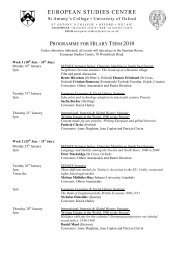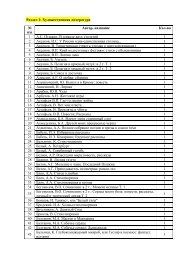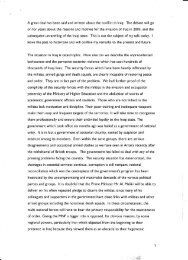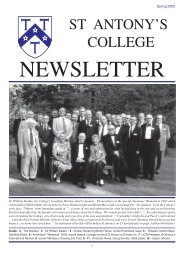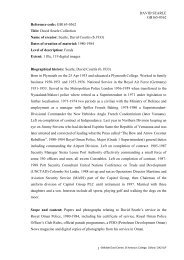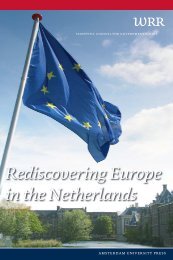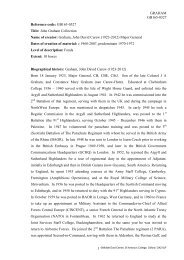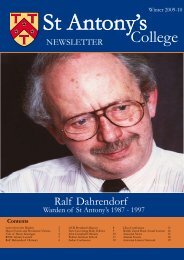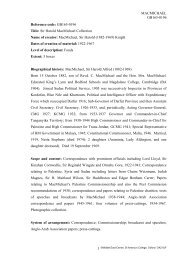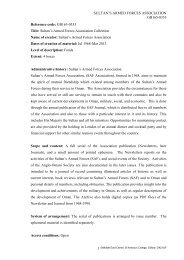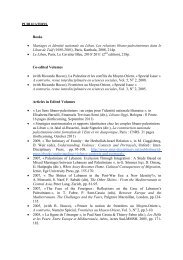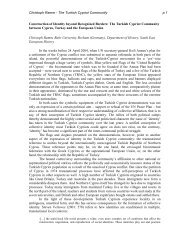Managing Migration: The Global Challenge, Population Bulletin, Vol ...
Managing Migration: The Global Challenge, Population Bulletin, Vol ...
Managing Migration: The Global Challenge, Population Bulletin, Vol ...
You also want an ePaper? Increase the reach of your titles
YUMPU automatically turns print PDFs into web optimized ePapers that Google loves.
<strong>Managing</strong> <strong>Migration</strong>: <strong>The</strong> <strong>Global</strong> <strong>Challenge</strong><br />
the first major immigration issue debated in Congress in<br />
the 21st century.<br />
Foreigners enter the United States through a front door<br />
for legal permanent immigrants, a side door for legal<br />
temporary migrants, and a back door for the unauthorized<br />
(see Table 2). About two-thirds of legal immigrants<br />
are family-sponsored, which means that family members<br />
in the United States asked the government to admit their<br />
relatives. <strong>The</strong>re are no limits on the number of immigrant<br />
visas available for immediate relatives of U.S. citizens,<br />
and 580,000 were admitted in 2006. <strong>The</strong>re is a cap on<br />
the number of immigrant visas available to relatives of<br />
permanent residents and more distant relatives of U.S.<br />
citizens. Only 222,000 were admitted in 2006, resulting<br />
in long waits for visas. For example, in 2008, Mexican<br />
spouses of U.S. immigrants will need to wait six years for<br />
immigrant visas, and adult brothers and sisters in Mexico<br />
of U.S. citizens face a 13-year wait. 18<br />
Legal temporary migrants are foreigners who come to the<br />
United States to visit, work, or study. <strong>The</strong>re are no limits<br />
on most types of temporary visitors; the United States is<br />
willing to accept more than the 30 million tourists and<br />
business visitors who arrived in 2006. Temporary foreign<br />
students and workers are more controversial. After the<br />
terrorist attacks of Sept. 11, 2001, the U.S. government<br />
required foreign students to undergo personal interviews<br />
before receiving visas to study in the United States and to<br />
pay a fee to support a database that tracks them while they<br />
are studying there.<br />
Guest workers receive visas that tie them to a U.S. employer<br />
and specify how long they can stay. H-1B visa holders,<br />
for example, have at least a college degree and fill jobs that<br />
Figure 5<br />
Status of Foreign-Born United States Residents, 2006<br />
Temporary Legal %<br />
Naturalized<br />
U.S. citizens<br />
%<br />
Legal Permanent<br />
Residents<br />
%<br />
Unauthorized<br />
%<br />
Source: Jeffrey S. Passel, “U.S. Immigration Trends: A Focus on U.S. Agriculture and<br />
California” (2008 presentation).<br />
normally require a college degree. <strong>The</strong>y can stay up to six<br />
years and “adjust” to regular immigrant status if their U.S.<br />
employer deems them uniquely qualified to fill the job.<br />
<strong>The</strong> number of guest workers admitted doubled in the<br />
1990s and almost doubled again to nearly 400,000 in<br />
2004, as Congress raised the cap at the request of hightech<br />
firms. 19 <strong>The</strong> annual cap on the number of H-1B<br />
visas available has now reverted to 65,000, but employers<br />
want far more. Critics of the H-1B program say that the<br />
easy availability of H-1B visas has discouraged American<br />
citizens from studying and working in science and<br />
engineering fields. 20<br />
Unauthorized foreigners are persons in the United<br />
States in violation of U.S. immigration laws. Demographer<br />
Jeff Passel estimated 11.5 million unauthorized<br />
foreigners in the United States in 2006, with the number<br />
increasing by 770,000 a year. 21 Of the 38.1 million<br />
foreign-born U.S. residents, 34 percent were naturalized<br />
U.S. citizens, 35 percent legal immigrants and temporary<br />
visitors, and 31 percent unauthorized (see Figure 5). Over<br />
half of the unauthorized foreigners entered the United<br />
States by evading border controls, while 45 percent entered<br />
legally but did not leave when required. 22<br />
Mexico<br />
Most Latin American countries send more people abroad<br />
than they receive as immigrants. Mexico is Latin America’s<br />
major emigration country, sending up to 500,000<br />
people (half of its net population increase) to the United<br />
States. Most made unauthorized entries. Mexico is also<br />
a transit country for Central Americans en route to the<br />
United States.<br />
Table 2<br />
Immigration Status of Foreigners in the United States,<br />
by Category, 2004-2006<br />
Naturalized U.S. citizens 2004 2005 2006<br />
Category<br />
(thousands) (thousands) (thousands)<br />
Legal immigrants Temporary Legal<br />
Immediate relatives of U.S. citizens<br />
958<br />
418<br />
1,122<br />
436<br />
1,266<br />
580<br />
Other family-sponsored immigrants 214 213 222<br />
Employment-based Legal Permanent Residents 155 247 159<br />
Refugees and asylees 370 460 381<br />
Diversity and other immigrants 99 83 88<br />
Unauthorized<br />
Estimated emigration 308 312 316<br />
Legal temporary migrants 30,781 32,003 33,667<br />
Pleasure/business 27,396 28,510 29,929<br />
Foreign students (F-1 visas)* 613 621 694<br />
Temporary foreign workers* 676 726 821<br />
Illegal immigration<br />
Apprehensions 1,264 1,291 1,207<br />
Removals or deportations 189 203<br />
Unauthorized foreigners** 770 770 770<br />
*Excludes their spouses and children.<br />
**Annual average based on estimated unauthorized entries between 2000 and 2006.<br />
Sources: Sources: DHS, 2006 Yearbook of Immigration Statistics: tables 6, 26, and 35; and Jeffrey S.<br />
Passel, “U.S. Immigration Trends: A Focus on U.S. Agriculture and California” (2008 presentation).<br />
<strong>Population</strong> <strong>Bulletin</strong> <strong>Vol</strong>. 63, No. 1 2008 www.prb.org 9



